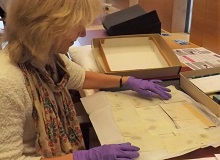


The University of Manchester has found that a text in Aramaic mentions the “Sabbath” and could fit with Ezekiel 46:1-3.

Mursilis was unsure if the storm god was indeed the reason for the plague that happened between 1350-1325 BCE. He panicked because libations and offerings were about to cease.

In the Bible, the concept of measurements and weight are intricately connected to the idea of judgement.

The processional way was approximately 250 meters long, 20 meters wide and was adorned with 120 lions. The Ishtar gate hosted the festival of the Babylonian new year.

In the Louvre Museum, Paris, there are several objects that will provide an interesting approach to biblical archaeology.

The copper mines are an evidence of a hierarchical and stable kingdom prior to the monarchy in Israel, as described in Genesis.

“Ash, arrowheads dating from the period, as well as Iron Age potsherds, lamps and a significant piece of period jewelry” have been unearthed. The findings appear to confirm the Biblical account of 2 Kings.

The letter, which has belong to the University of Basel for over 100 years, provides insights into the world of the first Christians, and is older than all previously known Christian documents from Roman Egypt.

A genetic study of the remains of an old cemetery confirms their Mediterranean origin, as the Old Testament says.

What did it mean to be a priest during the time of Moses? What ideas did the holiness of priests convey?

One of the most overlooked items in the Istanbul Archaeological Museum is the 8th century BCE marble Lamassu statue discovered in Assur, Iraq in 1845.

The 2,600-year-old seal bears the inscription “(belonging) to Nathan-Melech”, a name that appears in II Kings 23:11.

The Samaria Ostraca and LMLK Jar-Handles are two invaluable collections for any scholar intent on understanding the world of iron age Israel and Judah.

The tablet itself consists of 3 fragments that are pieced together, and 102 of the original 202 proverbs are preserved and legible.

The ring is engraved with a wine vessel surrounded by Greek letters spelling out “Pilatus”. Those rings were used to stamp official documents.

Expert German researchers said they showed “characteristics inconsistent with ancient origin”.

A relief in the Istanbul Archaeology Museum captures Sennacherib’s pride and character.

Tourists will be able to visit the 1,700-year old basilica, submerged in the Iznik lake.

The ruins are located in Manbij, one of Syria’s most ancient towns. Among the artifacts found, there were several versions of crosses etched into columns and walls, which indicate this was a significant site for Christians.

One of the symbols that are used for Asherah is the “tree of life”, this may also be a reason why the woods provided a natural setting for those who sought her help.

Who were these Canaanites whom God ordered to be annihilated? What did they believe, what did they practice? Why was their existence such a threat to ancient Israel?

Outside of Genesis, what do we know about the flood?

It is very important to answer this question, especially if one wants to argue for the possibility of the existence of a written Torah prior to 1000 BCE.

As two superpowers left the Levant, a power vacuum was created. Canaan was left alone, ripe for conquest.

The author of Ephesians makes the point that in Christ the barriers between God and humanity, and the artificial barriers that people have put up against each other are destroyed.

Las opiniones vertidas por nuestros colaboradores se realizan a nivel personal, pudiendo coincidir o no con la postura de la dirección de Protestante Digital.